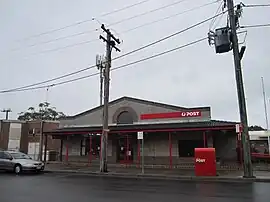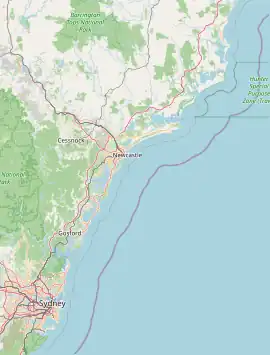| Swansea Greater Newcastle, New South Wales | |||||||||||||||
|---|---|---|---|---|---|---|---|---|---|---|---|---|---|---|---|
 Post office | |||||||||||||||
 Swansea | |||||||||||||||
| Coordinates | 33°05′06″S 151°38′06″E / 33.085°S 151.635°E | ||||||||||||||
| Population | 5,044 (2021 census)[1] | ||||||||||||||
| • Density | 1,576/km2 (4,080/sq mi) | ||||||||||||||
| Postcode(s) | 2281 | ||||||||||||||
| Area | 3.2 km2 (1.2 sq mi) | ||||||||||||||
| Location | |||||||||||||||
| LGA(s) | City of Lake Macquarie | ||||||||||||||
| Parish | Wallarah | ||||||||||||||
| State electorate(s) | Swansea | ||||||||||||||
| Federal division(s) | Shortland | ||||||||||||||
| |||||||||||||||
Swansea is a town at the entrance to Lake Macquarie from the Pacific Ocean in New South Wales, Australia. It is part of the City of Lake Macquarie local government area and is regarded as part of Greater Newcastle.
History
The Aboriginal people, in this area, the Awabakal, were the first people of this land.[2]
Swansea's local industries are coal mining, fishing, boating, and tourism. There were once several small coal mines. There are also popular fine sandy beaches on the Pacific Ocean, Swansea Channel and Lake Macquarie. It is 25.2 km away from the city of Newcastle, where many residents commute to for work.
References
- ↑ Australian Bureau of Statistics (28 June 2022). "Swansea (NSW) (State Suburb)". 2021 Census QuickStats. Retrieved 16 June 2023.
- ↑ "Aboriginal and Torres Strait Islander people". Lake Macquarie City Council. Retrieved 8 September 2020.
External links
- History of Swansea (Lake Macquarie City Library)
- Travel – Swansea (SMH) – includes history
This article is issued from Wikipedia. The text is licensed under Creative Commons - Attribution - Sharealike. Additional terms may apply for the media files.